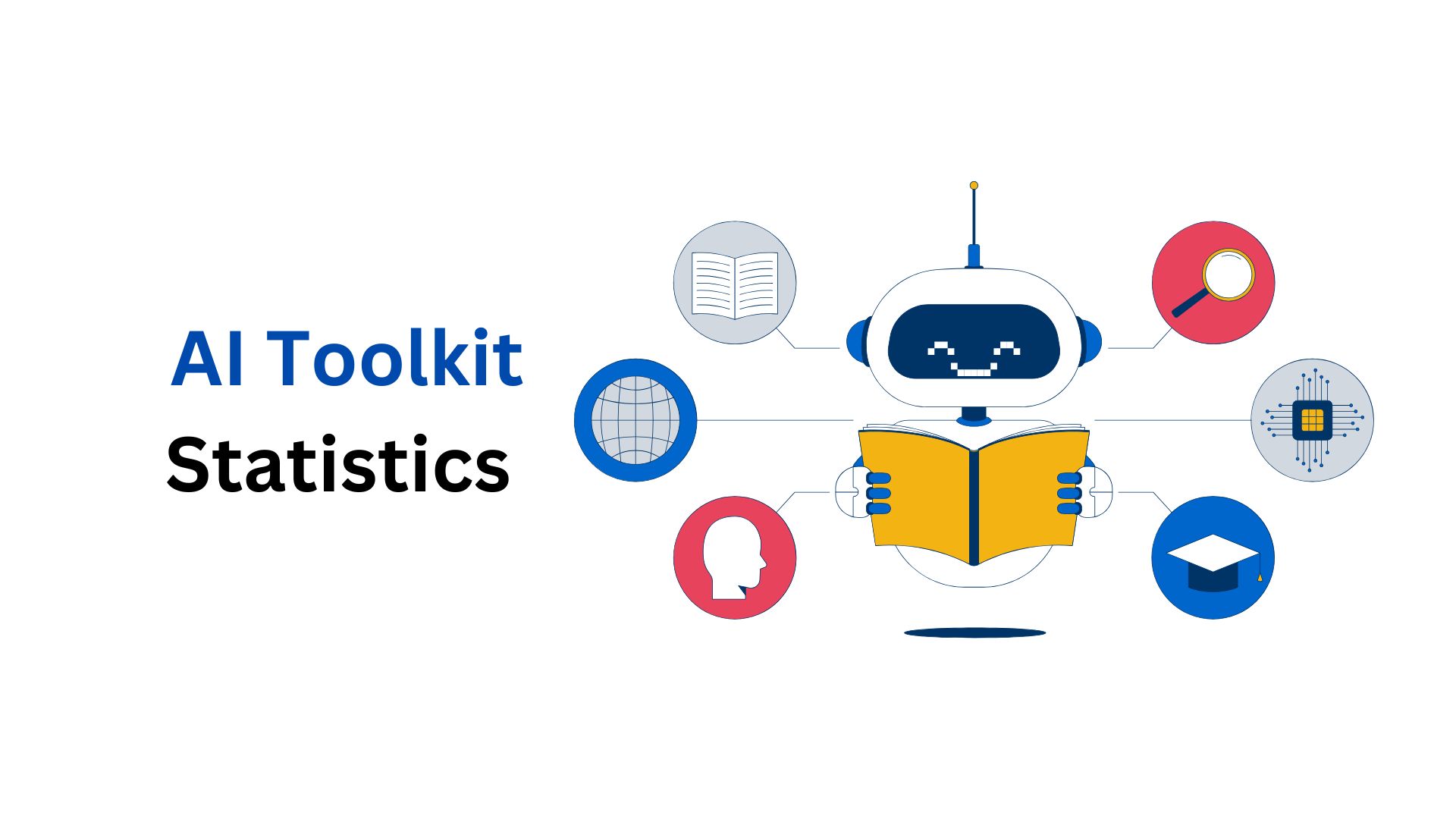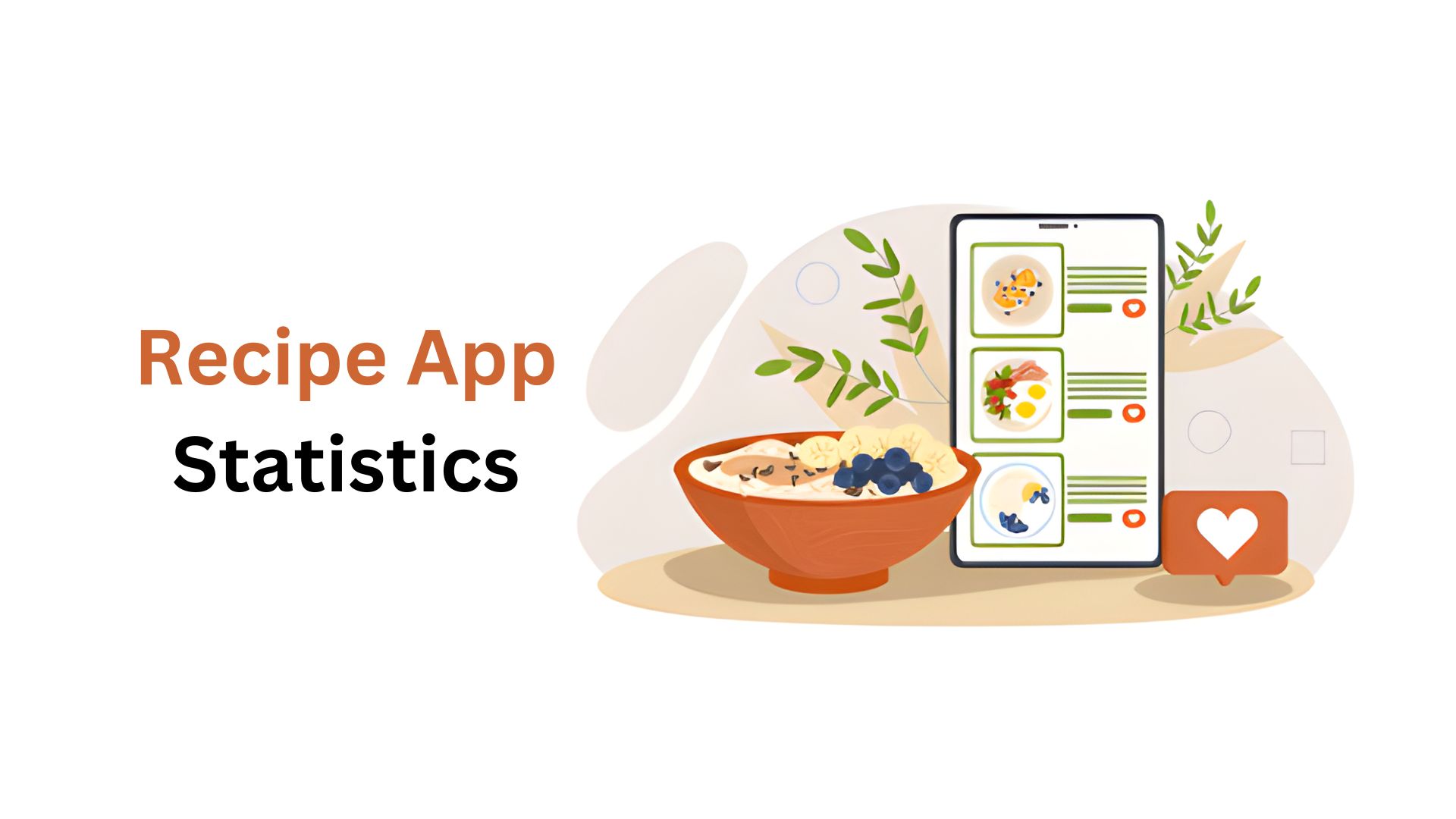Uber Eats Statistics By Users, Revenue, Market Share And Facts (2025)
Updated · Jul 02, 2025
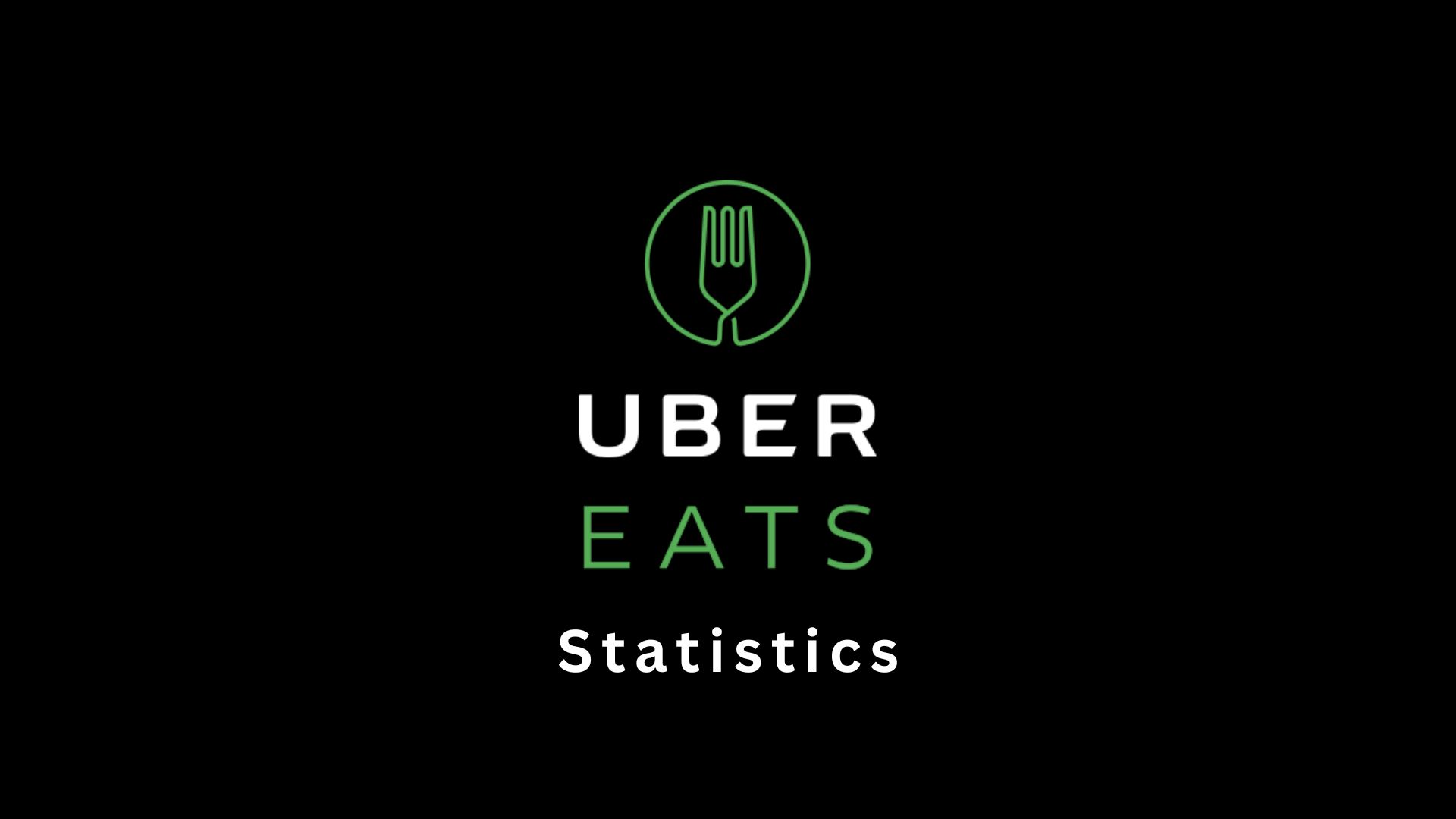
Table of Contents
- Introduction
- Editor’s Choice
- Key Facts
- Growth Potential For Global Online Food Delivery
- Uber Eats Audience
- Uber Eats Gross Bookings
- DoorDash Vs Uber Eats: Quarterly Marketplace GOV
- Uber Eats Adjusted EBITDA
- Uber Eats Revenue
- Uber Eats Users
- Uber Eats Availability In Cities
- Uber Eats Partnered Restaurants
- Uber Eats Market Share
- Uber Eats Expands Beyond Meal Delivery To Redefine eCommerce
- Conclusion
Introduction
Uber Eats Statistics: Uber Eats, the global food delivery platform launched in 2014, has grown to become a significant player in the online food delivery industry. Operating in over 6,000 cities worldwide, it serves millions of customers across the globe. The platform partners with over 700,000 restaurants and offers food delivery in more than 45 countries. In 2023, Uber Eats reported a revenue of approximately USD 12.5 billion. The service also continues to expand its user base, with over 100 million users actively using the app each month. In the U.S. alone, Uber Eats has a market share of around 25%, making it one of the leading food delivery platforms in the region.
The platform has increasingly leveraged its parent company Uber’s rideshare infrastructure to enhance its delivery network, further strengthening its position in the competitive food delivery market. The article takes you through the Uber Eats statistics and trends, eventually leading to an in-depth discussion around its market performance.
Editor’s Choice
- The US$1.28 trillion grocery delivery market should be reached by 2028, with grocery delivery expected to comprise about 70% of this market.
- In 2023, grocery delivery generated US$640B, while meal delivery generated US$390B, indicating greater growth for groceries.
- Uber Eats users, for the majority, fall within the age group of 18-44 years, with the bulk being from 25-34 years, representing 32.3% of users.
- Uber Eats’ gross bookings surpassed US$20 billion worldwide in Q4 2024, growing from US$13.9 billion in Q1 2022.
- By 2023, Uber Eats was the first food delivery aggregator to make profits, racking US$12B+ in revenues.
- Uber Eats statistics reveal that adjusted EBITDA for Uber Eats in Q1 2024 increased 83% to US$ 528 million from US$288 million year-on-year.
- Uber Eats revenue expanded from USD 0.6 billion in 2017 to USD 13.7 billion in 2024, which is considered marked and steady growth.
- The number of users grew from 5 million in 2016 to 95 million in 2024, nearly 19 times.
- Uber Eats went from 120 cities in 2017 to 11,500 cities across the world by 2024.
- The number of partner restaurants grew from 80,000 in 2017 to 1 million by 2024.
- As of May 2021, Uber Eats and Postmates combined are owned 27% in the U.S. food delivery market, second after DoorDash with 56%.
- Uber Eats charges around 30% for restaurants on delivery and 15% for pick-up, and negotiable, which is usually from 20 to 30%.
Key Facts
- Uber is a globally recognised ridesharing platform that started its own food delivery service in 2014 under the name Uberfresh, which was later renamed Uber Eats.
- By 2016, Uber had expanded the operations of Uber Eats outside the territory of the United States.
- In less than ten years, Uber Eats emerged as a major player in the online food delivery scene and is today regarded as the revenue champion among its global competition.
- By 2023, Uber Eats statistics show that the platform had sat in second place among food delivery apps downloaded in the U.S., with well over eleven million downloads.
- Uber’s interest in Grubhub was met with failure, but there was a successful acquisition of Postmates in 2020 to further its reach in the U.S.
- Uber Eats’ acquisition of Drizly, an alcohol delivery portal, in 2021 enhanced its presence in beverage and food e-commerce.
- As of early 2024, Uber had shut down Drizly and integrated alcohol sales directly into the Uber Eats app.
- Uber Eats held a 23% share of the U.S. online food delivery market, counting Postmates, as of March 2024, behind DoorDash.
- Globally, Uber Eats leads in the food delivery business in terms of revenue, above Delivery Hero and Just Eat Takeaway.com.
- It was the most downloaded food delivery app in France in 2023, and it was second in Germany and Spain while ranking fourth in the U.K.
- As of March 2024, Uber Eats was the leading food delivery brand in Japan, Australia, and the third most popular in Brazil.
- The brand has built a robust global presence and continues to chart its leadership in all market segments it enters.
- Nonetheless, Uber Eats is facing stiff competition and will have its work cut out for it in addressing issues such as long-term sustainable profitability in the industry.
Growth Potential For Global Online Food Delivery
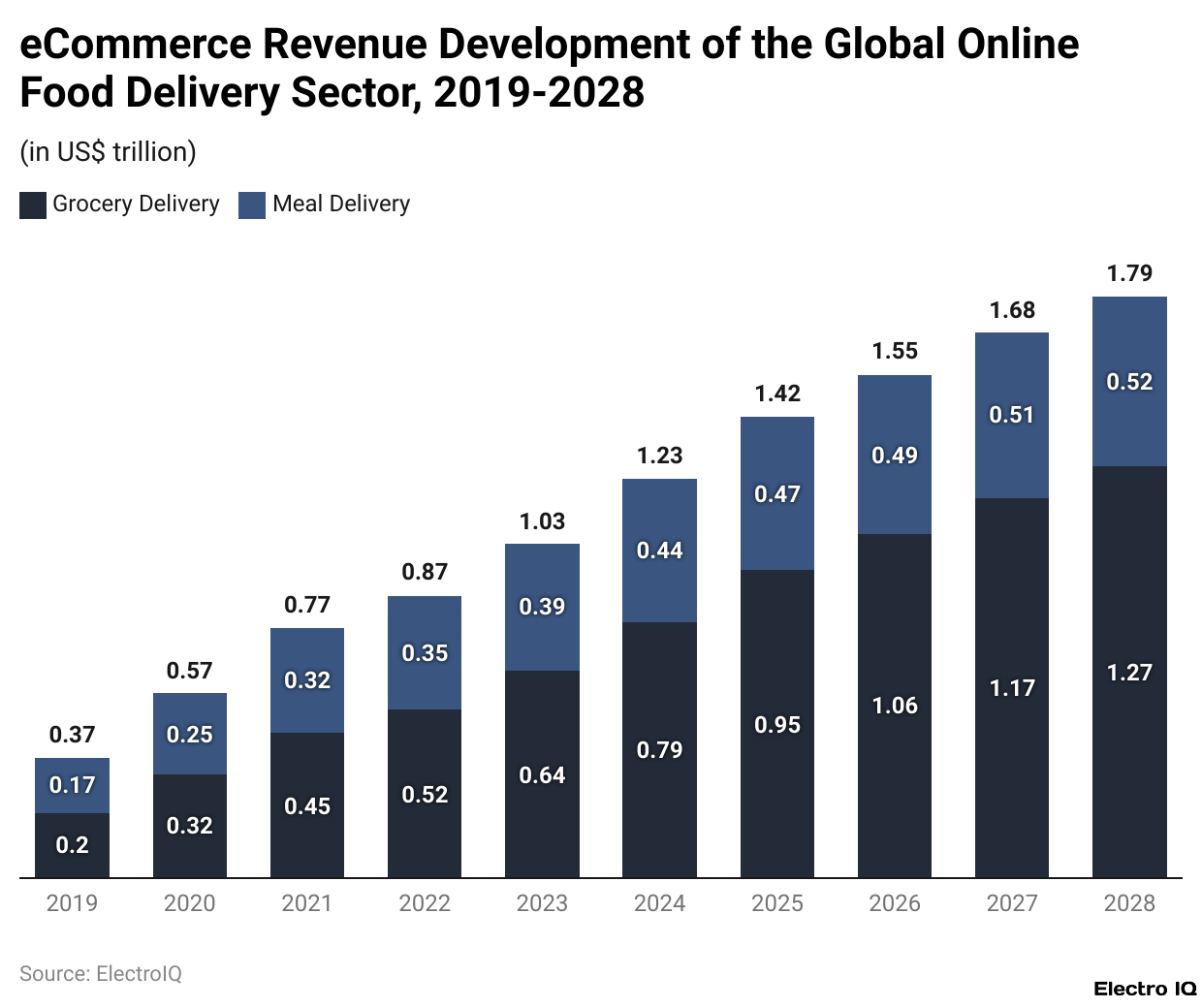
(Reference: static.ecommercedb.com)
- Uber Eats statistics forecasts indicate that the grocery delivery industry would achieve a staggering US$1.28 trillion by the year 2028, which can be viewed as an emerging trend globally towards online delivery services.
- In the year 2019, the combined revenue of the meal delivery and grocery delivery services was about US$370 billion.
- Over the next four years, the number grew by around 178% to arrive at US$1.03 trillion in 2023, with growth in grocery delivery outperforming that of meal delivery.
- Grocery delivery generated approximately US$640 billion against meal delivery with revenues of US$390 billion in 2023.
- Uber Eats statistics predicted that grocery delivery will continue registering a higher growth rate than meal delivery.
- The forecasted slower growth rate between 2023-2028 compared to the previous four years, will still see grocery delivery nearly doubling in value to reach some US$1.27 trillion by 2028.
- By this year, grocery delivery would be projected to account for about 70% of the overall delivery market, with meal delivery expected to be approximately US$520 billion.
Uber Eats Audience

(Reference: static.ecommercedb.com)
- The majority of Uber Eats users are between 18 and 44 years of age, with this group accounting for 74.5% of the platform’s users globally.
- The largest group of users falls into the 25-34 age range, accounting for 32.3% of overall users. The next-largest user group is the youngest, at 18-24 years old, which constitutes 22.9%.
- Use starts to drop off in the older age groups; 35-44-year-olds represent 19.3% of users, and those older than that represent the remaining 25.5% combined, indicating that younger adults use Uber Eats a lot more than older ones.
Uber Eats Gross Bookings
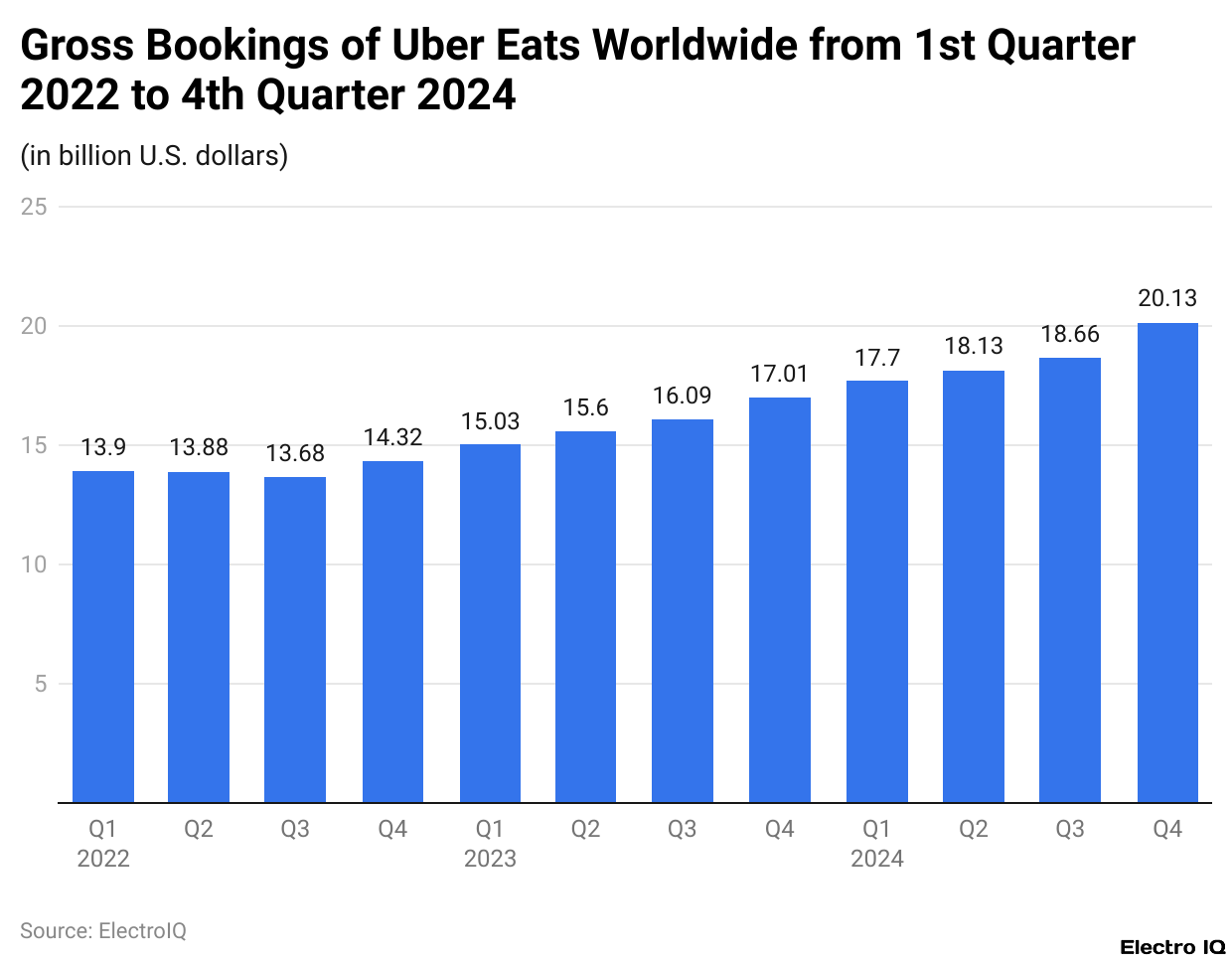
(Reference: statista.com)
- The strong growth of Uber delivery has primarily been driven by Uber Eats. Gross bookings on Uber Eats platforms globally exceeded US$20 billion in the fourth quarter of 2024 and marked a significant increase from around US$13.9 billion in the first quarter of 2022.
- In a short period, this figure shows how the platform has expanded its operations and customer reach.
- Uber Eats statistics reveal that in the year 2023, Uber Eats dominated the food-delivery market; it earned more than US$12 billion, surpassing two of its strongest rivals in the market, Delivery Hero and Just Eat Takeaway.
- It also made history as the very first food delivery aggregator to reach profitability. This milestone indicates a strengthening of financial strength and stability. Meanwhile, DoorDash is gaining ground, particularly boosted by acquiring Wolt in May 2022.
- Finally, DoorDash only made a little higher than Uber Eats from the closed date of 2022 until now, with its quarter gross order values.
- Now, these two companies boast proximity competition in their numbers every quarter, shining some light on their unending battle for power in the international food delivery space.
DoorDash Vs Uber Eats: Quarterly Marketplace GOV
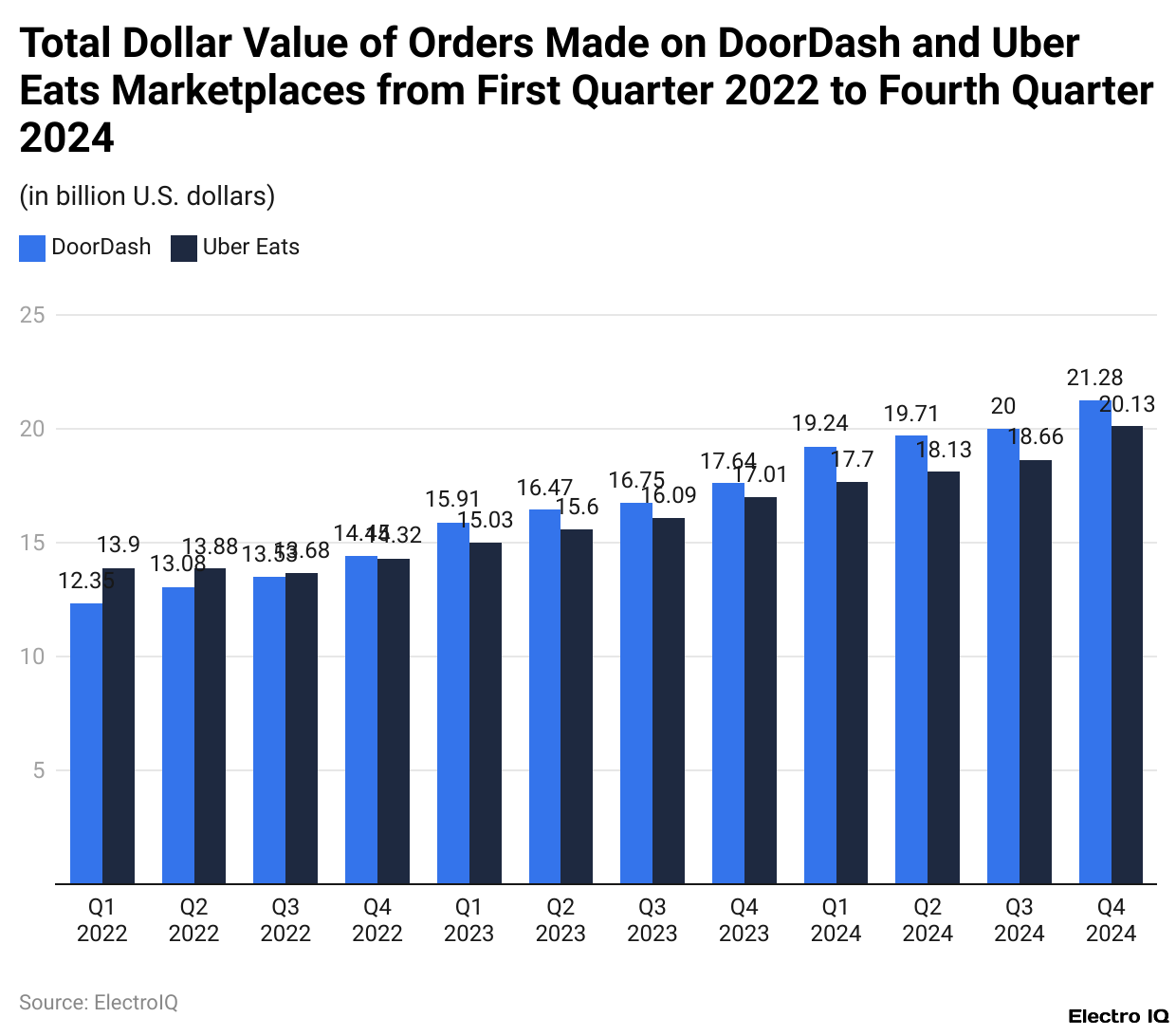
(Reference: statista.com)
- By the fourth quarter of 2024, DoorDash, including its subsidiary Wolt, reached about 21.3 billion U.S. dollars in total customer order value.
- In comparison, Uber Eats recorded slightly below that, with nearly 20.1 billion dollars during the same period.
- This implies that DoorDash has a higher volume or value of transactions on its platforms compared with those of Uber Eats towards the end of 2024.
Uber Eats Adjusted EBITDA
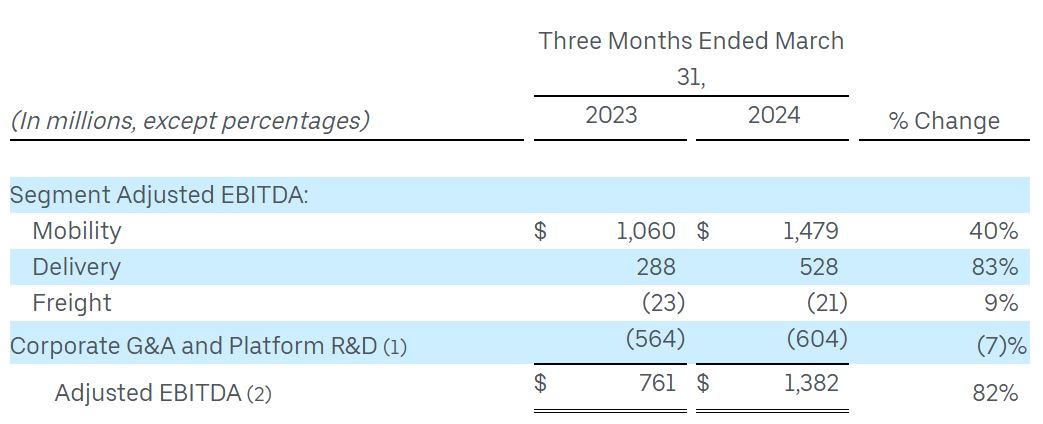
(Source: investor.uber.com)
- In the first quarter of 2024, Uber reported a stellar financial performance for most or less all its business segments.
- The mobility segment, which includes ride-hailing, increased its adjusted EBITDA from US$1,060 million in Q1 2023 to US$1,479 million in Q1 2024, thus reflecting a 40% increase.
- The Delivery segment, which is inclusive of Uber Eats, posted a more impressive performance with adjusted EBITDA increasing from US$288 million to US$528 million or a whopping 83% increase on a year-on-year basis.
- Slight improvement was seen in the Freight segment of Uber, with losses reduced from – US$23 million in 2023 to -US$21 million in 2024, an improvement of 9%.
- Corporate General and Administrative, as well as Platform Research & Development, accounted for increased expenses, though losses that were widening from -US$564 million to -US$604 million or a 7% decline.
- Uber’s total-adjusted EBITDA, overall, more than doubled year-over-year from US$761 million in the first quarter of 2023 to US$1,382 million in the same quarter of 2024-an increase of 82%.
- Such Uber Eats statistics depict solid performance and operational efficiency across its major revenue-generating sectors.
Uber Eats Revenue
| Year |
Revenue ($bn)
|
| 2017 | 0.6 |
| 2018 | 1.5 |
| 2019 | 1.9 |
| 2020 | 4.8 |
| 2021 | 8.3 |
| 2022 | 10.9 |
| 2023 | 12.1 |
| 2024 | 13.7 |
(Source: businessofapps.com)
- From 2017 to 2024, Uber Eats has experienced extreme revenue growth. In 2017, the platform was generating just US$0.6 billion.
- This totalled up to more than double to US$1.5 billion in 2018 and continued to climb to US$1.9 billion in 2019.
- The year 2020 saw a major jump in revenues at US$4.8 billion, likely due to the enhanced demand for food-delivery services during the COVID-19 pandemic.
- The growth certainly continued in the following years, when in 2021 Uber Eats reported US$8.3 billion in revenue and then US$10.9 billion in 2022.
- Uber Eats statistics indicate that by 2023, revenue had increased to US$12.1 billion, whereas 2024 reported US$13.7 billion.
- This continual uptrend indicates an increase in the user base of Uber Eats, wider market reach, and increasing demand for food delivery services around the world.
Uber Eats Users
| Year | Users (mm) |
| 2016 | 5 |
| 2017 | 9 |
| 2018 | 15 |
| 2019 | 21 |
| 2020 | 66 |
| 2021 | 81 |
| 2022 | 85 |
| 2023 | 88 |
| 2024 | 95 |
(Source: businessofapps.com)
- From 2016 to 2024, Uber Eats users had grown in number. The platform registered around 5 million users in 2016.
- By 2017, it had risen to 9 million, continuing its upward progression to 15 million in 2018 and 21 million in 2019.
- A big jump took place in 2020 when user numbers rose by more than three times to 66 million, probably owing to the worldwide shift towards online services due to the COVID-19 pandemic.
- By 2021, Uber Eats statistics show that it rose to 81 million users and 85 million in 2022. After that, the numbers grew slowly, with 88 million users in 2023 and 95 million users in 2024.
- All in all, Uber Eats gained almost 19 times more users in those nine years.
Uber Eats Availability In Cities
| Year |
Cities available
|
| 2017 | 120 |
| 2018 | 200 |
| 2019 | 500 |
| 2020 | 1,000 |
| 2021 | 6,000 |
| 2022 | 10,000 |
| 2023 | 11,000 |
| 2024 | 11,500 |
(Source: businessofapps.com)
- From 2017 to 2024, Uber Eats registered significant growth in the number of cities in which it operates. The service was operational in 120 cities in 2017. In 2018, the cities increased to 200, and in 2019, there were more than 500 cities in operation.
- The expansion further accelerated real-money games in 2020, when the service managed to conquer 1,000 cities worldwide.
- Major leaps were made in 2021 when it expanded into 6,000 cities and in 2022 with another major jump to reach 10,000 cities.
- Uber Eats continued its expansion in 2023 by adding 1,000 more cities, bringing the current number to 11,000, and by the year 2024, it had expanded to 11,500 cities worldwide.
- This steady growth grants a view into how aggressive Uber Eats has become in expanding globally.
Uber Eats Partnered Restaurants
| Year |
Supported Restaurants
|
| 2017 | 80,000 |
| 2018 | 100,000 |
| 2019 | 220,000 |
| 2020 | 600,000 |
| 2021 | 900,000 |
| 2022 | 825,000 |
| 2023 | 890,000 |
| 2024 | 1,000,000 |
(Source: businessofapps.com)
- From 2017 to 2024, there is a consistent increase in the partnership of the restaurants according to the Uber Eats platform. In the year 2017, around 80000 restaurants were tied to it.
- The following year, 2018, this increased to 100000 and well surpassed the mark in the year 2019 to 220000.
- The implementation of growth was very intense in 2020 when it reached 600000 partner restaurants through the driving factors of increased demand for food delivery services because of the pandemic. In 2021, it grew to a size of 900,000 partners.
- But again, in 2022, it fell to a maximum of 825,000 under possible post-pandemic adjustments or consolidation. In 2023, it rose to 890,000 again, an achievement for Uber Eats, supporting 1 million restaurants worldwide by 2024.
- This natural Uber Eats statistics growth indicates the ever-increasing global footprint of the platform and its growing influence in the food delivery industry.
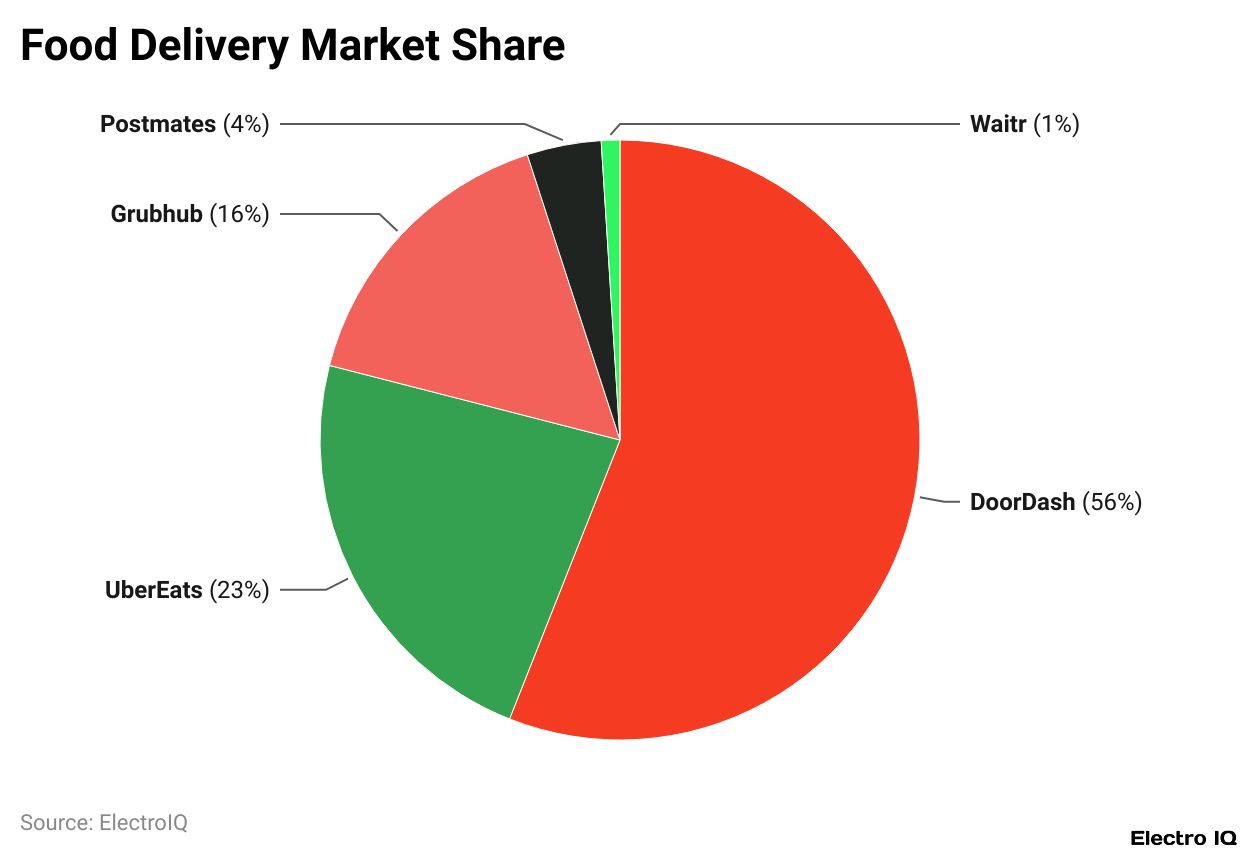
(Reference: appsthatdeliver.com)
- According to Uber Eats statistics, DoorDash occupies the first place and controls the U.S. meal delivery market by 56 %. It was followed by Uber Eats with 23 %.
- As for Postmates, which Uber bought for US$2.65 billion the previous year, the share was only 4 % of the market.
- In total, Uber’s share combined with Postmates became 27 %. Grubhub, together with subsidiaries such as Seamless and Eat24, forms 16% of the market, and another tiny player called Waitr is only able to capture one %.
- Restaurants on the Uber Eats platform typically have to pay 30% commission for delivery orders and 15% for pick-up orders.
- The rates are negotiable, although most still fall between 20% and 30%, depending on the deal with the restaurant.
- Such an economy, like a pandemic with a food delivery service, is a donor to investors; however, they still have concerns.
- Although Uber has tripled its gross bookings, the company has never been really profitable. Meanwhile, it continues to show a consistent yearly drop in losses, indicating that it may reach profitability one day, especially if markets keep consolidating.
- Uber Eats and similar companies have also built dark kitchens for the mere purpose of cooking food for delivery.
- The U.S. restaurant industry is undergoing a dark change in its worth, about US$863 billion. Families are ordering more food to be delivered, and reliability increases: these apps are transforming the traditional model for restaurants.
- These spaces are irrelevant to restaurants now. With even the smallest kitchen space, one can produce meals for delivery. This means there are no wait staff required, and restaurants need not invest in furnishings for dining.
- For users, it is a completely seamless experience; they may never know that the restaurant they’re ordering from exists only virtually, with no physical dining room at all.
Uber Eats Expands Beyond Meal Delivery To Redefine eCommerce
- Uber Eats involves lots of evolution, thereby broadening its partnerships and engagements.
- Food delivery platforms usually source restaurants as partners to deliver cheap and convenient meals directly to the consumer.
- But Uber Eats mean to take it a little further. From Fall 2022 onward in the U.S., Uber Eats has partnered with major retailers or supermarket chains as Costco and Carrefour.
- This partnership allows Uber Eats to offer all kinds of products, including groceries, thus bypassing additional costs and logistics that come with dark store operations- these are warehouse-style fulfilment centres used by some competing firms to render swift service.
- With Uber Eats working this same angle in the UK, the items of choice in the rest of Europe share a paramount advantage: Items like snacks, beverages, cigarettes, or household items may be added to an order at no extra delivery cost after a customer places a meal order from stores along the driver routing.
- Towards the tail end of 2023, Uber Eats forged a partnership with Getir, a once-secretive player in the quick commerce sector.
- However, this dynamic shifted in early 2024 as Getir pulled out of most European markets owing to its dark store business model that turned out to be unsustainable in the face of high operating costs and sporadic order volumes.
- This unexpected windfall for Uber Eats is attributable to the consolation offered by collaboration with the parent U.S. company. While independent startups such as Getir would find it difficult to cope with this upheaval, Uber Eats would find it easier to absorb any turbulence since it is under a large stable U.S. company.
- Many former Getir affiliates and former customers of Getir have now turned to Uber Eats in fulfilment of their delivery needs, thereby fortifying its standing on the eCommerce landscape.
Conclusion
Uber Eats statistics show a great performance in 2024, which flags the importance of Uber Eats in the global food delivery industry. With revenue taking a gigantic leap, with a rising user base and a staid presence in the market, the platform has fairly exhibited tenacity and ingenuity while facing cut-throat competition. Investments in tech and sustainability allow for Uber Eats’ continued conquest and innovation.
FAQ.
Uber Eats has maintained tremendous growth since its inception. From around 5 million users in 2016, it increased to about 95 million users by 2024; hence, 19 times the amount. Revenue has also been on the rise: from US$0.6 billion in 2017 to US$13.7 billion in 2024, thus further indicating an increase in demand for food delivery services worldwide.
Uber Eats started 2024 with about 23% of the U.S. food delivery market, including the one from its subsidiary Postmates, whereas DoorDash led with about 56%. Therefore, Uber Eats competes strongly on the international front, even outranking its rivals like Delivery Hero and Just Eat Takeaway.com in terms of global revenue.
Young adults tend to represent the most significant number of users on the platform. People aged 25-34 compose the largest share at 32.3%, followed by age groups 18-24 at 22.9% and 35-44 at 19.3%. All in all, 74.5% of users fall under the age bracket of 18-44, firmly positioning Uber Eats in preference among the younger demographic.
Uber Eats’ move into grocery and retail delivery sees collaborations with stores such as Costco and Carrefour to provide household supplies, booze, and snacks together with food. Quick commerce, as Uber terms it, allows the customers to receive a large variety of products in one delivery without incurring additional charges, which is a shift in strategy that differentiates Uber Eats from its rivals.
Indeed, Uber Eats hit a historic milestone of being the first food delivery aggregator to earn profits in 2023. With an 83% y-o-y growth of adjusted EBITDA, its results stood at US$288 million in Q1 2023 and US$528 million in Q1 2024, which reflects impressive operational efficiency and financial advancement.

Maitrayee Dey has a background in Electrical Engineering and has worked in various technical roles before transitioning to writing. Specializing in technology and Artificial Intelligence, she has served as an Academic Research Analyst and Freelance Writer, particularly focusing on education and healthcare in Australia. Maitrayee's lifelong passions for writing and painting led her to pursue a full-time writing career. She is also the creator of a cooking YouTube channel, where she shares her culinary adventures. At Smartphone Thoughts, Maitrayee brings her expertise in technology to provide in-depth smartphone reviews and app-related statistics, making complex topics easy to understand for all readers.

